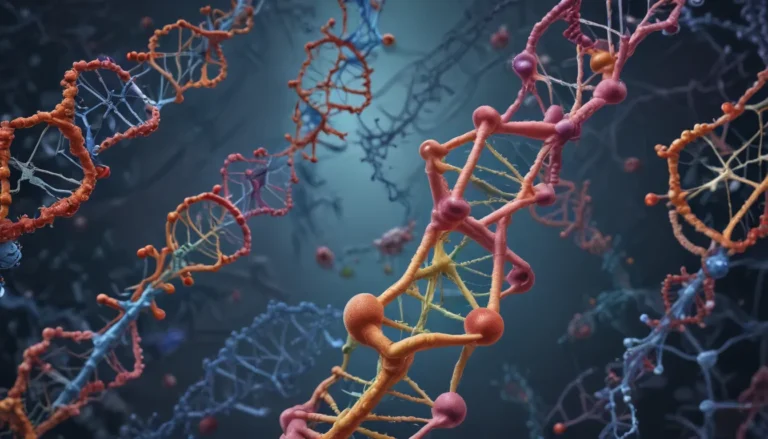A Note About Images: The images used in our articles are for illustration purposes only and may not exactly match the content. They are meant to engage readers, but the text should be relied upon for accurate information.
Have you ever pondered the mysteries of speciation and how new species come into existence? Sympatric speciation is a captivating phenomenon that challenges traditional notions of how species evolve. What if I told you that new species can emerge from a common ancestor within the same geographical area, without any physical barriers separating them? This process, known as sympatric speciation, relies on intriguing mechanisms such as ecological differentiation, disruptive selection, and sexual selection to drive the formation of distinct species.
In this article, we will embark on a journey to unravel the enigmatic world of sympatric speciation by exploring 20 fascinating facts. From the origin of new species in the absence of physical barriers to the role of natural and sexual selection, we will delve into the complexities that shape the evolution of biodiversity. Are you ready to discover the secrets behind the emergence of new species and how life evolves in intriguing ways? Let’s dive in and unlock the mysteries of sympatric speciation together.
Sympatric Speciation Unveiled: A Closer Look
Sympatric speciation unfolds when a single population fragments into two or more distinct populations within the same geographic area. Unlike traditional speciation, which often requires geographic isolation, sympatric speciation challenges this notion by showcasing the emergence of new species despite the absence of physical barriers that would typically restrict gene flow between populations. What drives this remarkable process, you may wonder? Factors like ecological, behavioral, and genetic changes play pivotal roles in triggering sympatric speciation.
- Sympatric speciation challenges the idea that species can only evolve in separate areas, leading to a more dynamic and diverse natural world.
- It can happen rapidly, involving environmental, behavioral, and genetic factors, resulting in the creation of new species with unique traits.
Unraveling the Mechanisms of Sympatric Speciation
Polyploidy: A Common Path to Speciation
One common mechanism of sympatric speciation is polyploidy, characterized by the presence of more than two sets of chromosomes. This genetic deviation can lead to reproductive isolation between individuals with different chromosome numbers, preventing successful interbreeding and paving the way for the formation of new species.
Plants vs. Animals: A Propensity for Speciation
Interestingly, sympatric speciation is more likely to occur in plants than in animals. Plants possess a higher propensity for speciation due to their unique abilities to self-fertilize or cross-pollinate with closely related species. This botanical advantage contributes to the diversification of plant species through sympatric speciation.
Rapid Evolution: The Swift Emergence of New Species
Intriguingly, sympatric speciation can occur rapidly, within a few generations. Environmental pressures and genetic mutations can drive swift changes in a population, leading to the emergence of new species in a relatively short period. This rapid evolution challenges the conventional notion of speciation as a gradual process and showcases the dynamic nature of life’s evolutionary pathways.
Fluid Species Boundaries: Redefining the Concept of a “Species”
As sympatric speciation gives rise to new species within the same geographic area, the traditional definition of a species becomes more fluid and dynamic. The occurrence of sympatric speciation blurs the boundaries between species, challenging our understanding of what defines and distinguishes one species from another in a constantly evolving natural world.
Beyond Speciation: Exploring the Consequences of Sympatric Speciation
Hybrid Zones: Where Species Meet and Mix
Sympatric speciation can result in the formation of hybrid zones, where individuals from different species interact and occasionally interbreed, giving rise to hybrid offspring. These hybrid zones serve as dynamic regions of genetic exchange and evolutionary innovation, showcasing the intricate interplay between diverging species.
Reproductive Barriers: The Evolutionary Roadblocks
In some cases, sympatric speciation may lead to the evolution of reproductive barriers. Changes in mating behaviors or the timing of reproductive cycles can act as barriers that reinforce speciation by preventing genetic mixing between populations. These reproductive barriers play a crucial role in maintaining the genetic distinctness of emerging species.
Natural Selection: Shaping the Evolutionary Landscape
The genetic changes driving sympatric speciation are often influenced by natural selection. Positive selection for specific traits can drive the divergence of populations within the same geographic area, leading to the emergence of distinct species with unique genetic and phenotypic characteristics. Natural selection serves as a potent force in shaping the evolutionary landscape of sympatric speciation.
Sympatric Speciation in the Wild: Observations and Insights
Diversity Across Habitats: Terrestrial and Aquatic Sympatric Speciation
Sympatric speciation is not confined to a specific habitat and can occur in various environments, including terrestrial and aquatic habitats. From lush forests to flowing rivers, sympatric speciation manifests in diverse ecosystems, highlighting the adaptability and resilience of life in the face of evolutionary challenges.
Active Research and Ongoing Debates: Exploring the Frontiers of Science
Sympatric speciation remains a topic of active research and debate among biologists, drawing attention to the complex mechanisms and factors driving the evolution of new species. Scientists continue to investigate the mysteries of sympatric speciation, seeking to unravel the intricacies of this enigmatic process and deepen our understanding of evolutionary diversification.
Diverse Organisms, Singular Phenomenon: Sympatric Speciation in Action
Sympatric speciation has been observed in a wide range of organisms, including insects, fish, and plants. Noteworthy examples include cichlid fish in African lakes and the apple maggot fly, showcasing the versatility and universality of sympatric speciation across different species and ecosystems.
Insights into Evolutionary Diversification: Unraveling Nature’s Tapestry
The study of sympatric speciation offers valuable insights into the processes of evolutionary diversification, shedding light on how biodiversity arises and how new species emerge from shared ancestral populations. By unraveling the genetic, ecological, and behavioral mechanisms underlying sympatric speciation, scientists gain a better understanding of the dynamic forces driving species formation and adaptation.
Unveiling the Enigma: The Continuing Saga of Sympatric Speciation
The Power of Disruptive Selection: A Catalyst for Change
Disruptive selection plays a significant role in sympatric speciation by favoring extreme phenotypes over intermediate ones within a population. This selective pressure can drive the divergence of populations and ultimately lead to the formation of new species with distinct traits and characteristics.
Mate Preference and Sexual Selection: Influencing Speciation Pathways
Changes in mate preference and sexual selection can also contribute to sympatric speciation by driving reproductive isolation and shaping the evolution of new species. Differences in mate choice and mating behaviors play a crucial role in the formation of reproductive barriers that maintain genetic distinctness between populations.
Challenging Species Boundaries: Redefining Nature’s Diversity
The occurrence of sympatric speciation challenges our conventional understanding of species boundaries, raising questions about how we define and classify species in a dynamic and ever-evolving natural world. As new species emerge within the same geographic area, the concept of a “species” becomes more nuanced and fluid, highlighting the complex interplay between genetic, ecological, and behavioral factors in shaping evolutionary pathways.
Conclusion: A Journey Into the Enigmatic Depths of Sympatric Speciation
In conclusion, sympatric speciation unveils a world of evolutionary marvels where new species emerge from shared ancestral populations, defying traditional barriers to speciation. Through the interplay of genetic mutations, ecological changes, and behavioral adaptations, sympatric speciation showcases the dynamic and intricate processes that drive the formation of new species within the same geographic area.
As we explored 20 enigmatic facts about sympatric speciation, we unraveled the mysteries of polyploidy, disruptive selection, sexual selection, and genetic mutations that catalyze speciation events. By understanding the mechanisms behind sympatric speciation, scientists gain valuable insights into the complex processes shaping biodiversity and evolutionary dynamics on our planet.
Sympatric speciation continues to captivate scientists and inspire further research, offering a window into the multifaceted world of evolutionary biology. As we delve deeper into the enigma of speciation, we unravel nature’s tapestry of diversity, adaptation, and the enduring legacy of life’s evolutionary journey.
FAQs: Exploring Common Questions About Sympatric Speciation
-
What is sympatric speciation?
Sympatric speciation refers to the formation of new species within the same geographical area from a single ancestral species, without physical barriers separating populations. -
What are the mechanisms of sympatric speciation?
Sympatric speciation can occur through processes such as disruptive selection, polyploidy, sexual selection, genetic mutations, and hybridization, driving the divergence and formation of new species. -
How does disruptive selection lead to sympatric speciation?
Disruptive selection favors extreme phenotypes within a population, driving the divergence of populations with different traits and characteristics, ultimately leading to the formation of new species. -
What is polyploidy and its role in sympatric speciation?
Polyploidy involves the duplication of chromosome sets, leading to the formation of new species by creating reproductive barriers that prevent gene flow between polyploid and diploid populations. -
How does sexual selection contribute to sympatric speciation?
Sexual selection influences the evolution of distinct mating behaviors and physical characteristics, leading to reproductive isolation between populations and the formation of new species within a shared habitat. -
Can sympatric speciation occur without genetic mutations?
Genetic mutations play a crucial role in sympatric speciation by introducing new genetic variation that drives divergence and speciation events. While speciation can occur without mutations, genetic changes significantly enhance the process. -
How does hybridization contribute to sympatric speciation?
Hybridization involves the mating of individuals from different populations or species, sometimes resulting in the formation of new species through genetic exchange and the evolution of reproductive barriers. -
Is sympatric speciation a common phenomenon?
While sympatric speciation was once considered rare compared to allopatric speciation, recent research has highlighted its occurrence in various organisms, suggesting that it may be more common than previously believed.
Unraveling Nature’s Enigmatic Forces: A Journey of Discovery
Sympatric speciation’s enigmatic nature sparks curiosity about evolution’s intricate mechanisms. Unraveling genetic drift’s mysteries, discovering natural selection’s astounding power, and exploring evolutionary biology’s fascinating facts deepen understanding. Investigating these interconnected concepts illuminates life’s incredible diversity, adaptations, and the complex processes shaping our world.
Our commitment to delivering trustworthy and engaging content is at the heart of what we do. Each fact on our site is contributed by real users like you, bringing a wealth of diverse insights and information. To ensure the highest standards of accuracy and reliability, our dedicated editors meticulously review each submission. This process guarantees that the facts we share are not only fascinating but also credible. Trust in our commitment to quality and authenticity as you explore and learn with us.
Sympatric speciation invites us to unravel the mysteries of life’s evolutionary journey, showcasing the dynamic and diverse pathways that lead to the emergence of new species. As we peel back the layers of genetic, ecological, and behavioral mechanisms shaping speciation events, we gain a deeper appreciation for the complexity and beauty of nature’s evolutionary tapestry. Join us on this enlightening expedition into the enigmatic depths of sympatric speciation, where each discovery unveils a new facet of life’s ongoing evolution.






